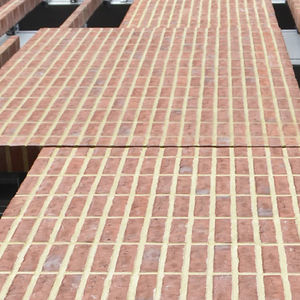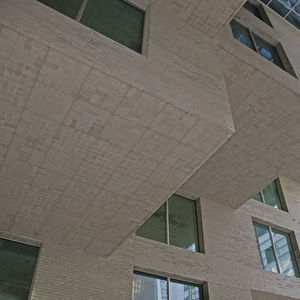

- Company
- Products
- Catalogs
- News & Trends
- Exhibitions
Prestressed concrete lintel CARLSBERG BJÆLKER™load-bearinghorizontal






Add to favorites
Compare this product
Characteristics
- Material
- prestressed concrete
- Function
- load-bearing
- Other characteristics
- horizontal
Description
Pre-stressed 1- and 2-layer lintels rarely have to support any loads, as the back-up walls represent the bearing structure for a roof or a floor division.
By using TB-Trough instead of traditional roofing felt over brick lintels, an improved strength of the brick beams is achieved.
Pre-stressed lintels guarantee that:
No displacement cracks appear through support
A lintel never lays or presses on window and door frames
The crossbars - on which the brick beams lay - must be on both sides at least 1/2 bricks.
Up to 12 bricks (2,870 mm) long.
Used for light distances of maximum 2,630 mm.
Up to 22 bricks (5,270 mm) long.
Used for light distances of maximum 5,040 mm.
The existing masonry doesn't represent a load for the pre-stressed front lintel, as long as no masonry paper is inserted in the length joints, as the lintel and the masonry form a composed brick beam. On the contrary, it relieves, because it divides the load.
The number of the masonry layers lying over the lintel is thus important for the calculation of the correct lintel size.
For the gable surface it's important to consider the minimum number of layers, as well as the maximum.
The sizing and static calculation are included in the price, in the case of pre-stressed lintels in standard format, from Carlsberg Bjælker™.
Catalogs
No catalogs are available for this product.
See all of Randers Tegl A/S‘s catalogsRelated Searches
- Exterior cladding brick
- Brick
- Contemporary cladding brick
- Facade cladding brick
- Facade brick
- Clinker cladding brick
- Solid brick
- Clay cladding brick
- Brick look cladding brick
- Glued cladding brick
- Old support cladding brick
- Red cladding brick
- Embossed cladding brick
- Smooth cladding brick
- Embossed brick
- High-resistance cladding brick
- Renovation cladding brick
- Textured cladding brick
- Masonry brick
- Brown cladding brick
*Prices are pre-tax. They exclude delivery charges and customs duties and do not include additional charges for installation or activation options. Prices are indicative only and may vary by country, with changes to the cost of raw materials and exchange rates.






